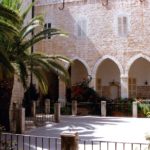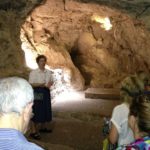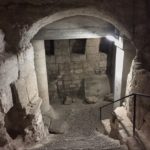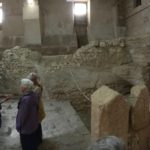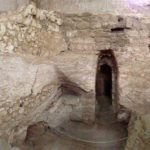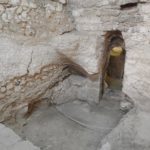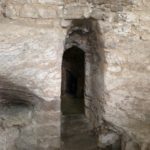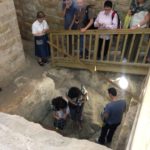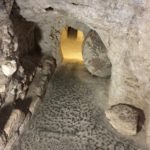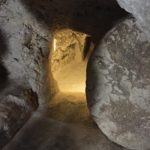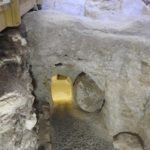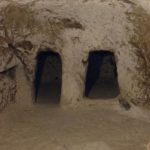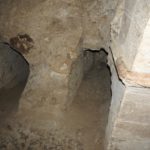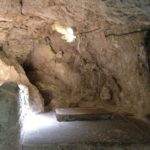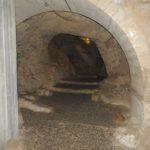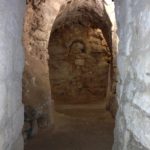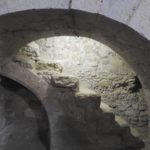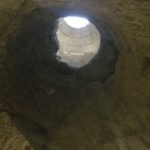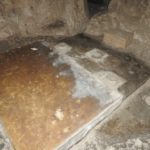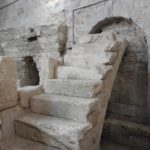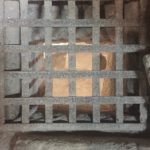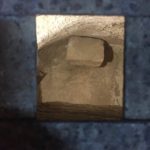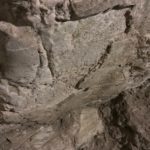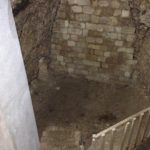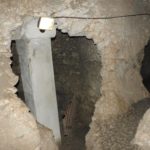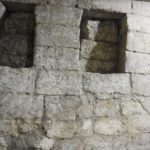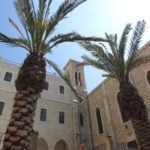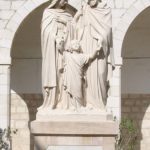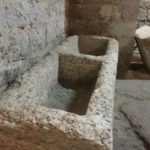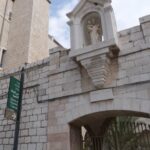Israel
In central Nazareth, just 100 metres from the Church of the Annunciation, is a lesser-known site that may include the remains of Jesus’ childhood home.
Archaeological research in 2006-10 indicated that an underground complex beneath the convent of the Sisters of Nazareth in 6166 Street may be the location of the long-lost Church of the Nutrition.
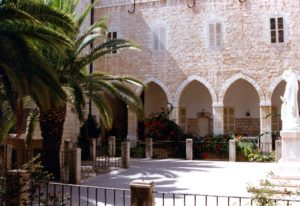
Sisters of Nazareth convent, whose courtyard covers an underground complex (© Nazareth360.com)
According to a seventh-century pilgrim, this Byzantine-era church was believed to have been built over the house of Mary and Joseph, where the young Jesus was nurtured. Rebuilt by the Crusaders, it was finally destroyed by fire, probably in the 13th century.
“Was this the house where Jesus grew up? It is impossible to say on archaeological grounds,” lead archaeologist Dr Ken Dark has written. “On the other hand, there is no good archaeological reason why such an identification should be discounted.”
Dr Dark also said the scale of the church and its surrounding structures indicate that Nazareth was a much larger and more important 6th-century pilgrimage centre than previously realised.
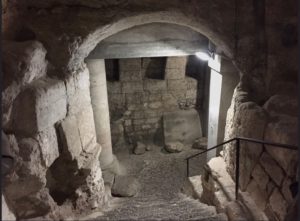
Ancient and modern structures at the base of ancient steps leading into the cave church (© American Friends of the Episcopal Diocese of Jerusalem)
Complex discovered by chance
The Sisters of Nazareth convent was established by a group of French nuns who arrived in 1881. Archaeological evidence was discovered by chance while they were building their house.
They uncovered a complex sequence of well-preserved underground spaces, including Crusader-era walls and vaults, a Byzantine cave-church, Roman-period tombs and other rock-cut and built structures.
The sisters, who operate a school for deaf and blind children, established a small museum for the pottery, coins, glass and other artefacts they found.
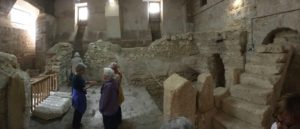
Panoramic view of first-century house with Crusader steps on right (© American Friends of the Episcopal Diocese of Jerusalem)
When new convent buildings were constructed around 1900 the walls of a large and richly-decorated Byzantine church, rebuilt in the Crusader period, were revealed. Bigger than the Byzantine Church of the Annunciation, it had a triple apse, colourful wall and floor mosaics and white marble fittings.
These discoveries remained almost unknown until 2006 when the Nazareth Archaeological Project began a five-year study, directed by Dr Dark, an archaeologist from the University of Reading in England.
House was well preserved
Dr Dark concluded that the large church, standing at ground level, was the Church of the Nutrition, and that its crypt contained what the Byzantines believed was the house where Jesus was brought up.
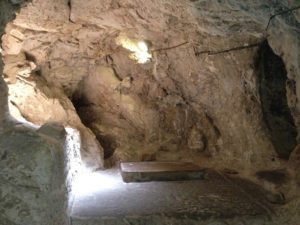
View of the cave church with a raised stone indicating the place of the altar (© Gregory Jenks)
Because it was protected, the house was in an excellent state of preservation, he said. “Great efforts had been made to encompass the remains of this building within the vaulted cellars of both the Byzantine and Crusader churches, so that it was thereafter protected.”
The house stood between two tombs, hewn from rock after the house was no longer used (which would not conflict with Jewish purity laws). Their mosaic decorations indicated they may have been of special importance. The presence of the tombs matched the seventh-century pilgrim’s eyewitness description of the Church of the Nutrition.
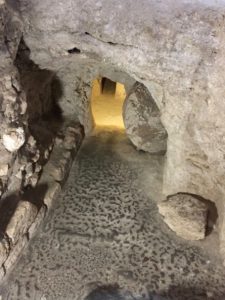
Rolling stone at entrance to burial cavities (© American Friends of the Episcopal Diocese of Jerusalem)
(Confusingly, the nearby modern Church of St Joseph has also been called the Church of the Nutrition in the belief that it is on the site of Joseph’s home, where Jesus was raised.)
One of the tombs, whose forecourt cuts through a wall of the house, has a rolling stone at its entrance. It has become known as “the Tomb of the Just One” in the belief that it may have been venerated as the tomb of St Joseph — though in Dr Dark’s opinion it is unlikely to be where he was buried, given that it dates to after the house was disused.
Related site:
Administered by: Sisters of Nazareth
Tel.: 972-4-6554304
Open: By appointment only.
- Sisters of Nazareth convent, whose courtyard covers an underground complex (© Nazareth360.com)
- Sr Stefania talking to visitors in the cave church (© Gregory Jenks)
- Ancient and modern structures at the base of ancient steps leading into the cave church (© American Friends of the Episcopal Diocese of Jerusalem)
- Panoramic view of first-century house with Crusader steps on right (© American Friends of the Episcopal Diocese of Jerusalem)
- Panoramic view of first-century house with surviving plaster at far left (© Gregory Jenks)
- Inside the first-century cave house (© Gregory Jenks)
- Detail of rock-cut doorway in the first-century house (© Gregory Jenks)
- Access to the venerated burial cave (© Gregory Jenks)
- Rolling stone at entrance to burial cavities (© American Friends of the Episcopal Diocese of Jerusalem)
- Close-up of rolling stone (© American Friends of the Episcopal Diocese of Jerusalem)
- View of rolling stone entrance (© Gregory Jenks)
- Kokhim tombs inside the venerated cave (© Gregory Jenks)
- Another view of two kokhim tombs adjacent to main ritual cave (© Gregory Jenks)
- View of the cave church with a raised stone indicating the place of the altar (© Gregory Jenks)
- Underground passageways between the caves (© Gregory Jenks)
- Internal view of caves with mix of artificial and natural forms (© Gregory Jenks)
- Crusader steps enclosed within modern support structures for the convent (© Gregory Jenks)
- Lightwell designed to let natural light fall on the altar of the cave church (© American Friends of the Episcopal Diocese of Jerusalem)
- Altar location in cave church (© Gregory Jenks)
- Crusader steps leading to grille offering a view into venerated cave (© Gregory Jenks)
- Metal grille, probably Crusader, placed to allow pilgrims to view the cave-church altar (© Gregory Jenks)
- View into venerated cave from above through metal grille (© Gregory Jenks)
- Surviving plaster on wall of main ritual cave (© Gregory Jenks)
- Large water cistern (© Gregory Jenks)
- Ancient and modern elements in large water cistern (© Gregory Jenks)
- Masonry elements near main ritual cave (© Gregory Jenks)
- Bell tower above chapel at Sisters of Nazareth convent (© Gregory Jenks)
- Modern statue of Holy Family in convent courtyard, reflecting the belief that this was where Jesus grew up (© Nazareth360.com)
- Double stone manger found in convent grounds and relocated to the ruins before the modern structure was erected (© American Friends of the Episcopal Diocese of Jerusalem)
- Entrance to the Sisters of Nazareth convent (Seetheholyland.net)
References
Dark, Ken: “The Byzantine Church of the Nutrition in Nazareth Rediscovered”, Palestine Exploration Quarterly, 144, 3, 2012.
Dark, Ken: “Early Roman-Period Nazareth and the Sisters of Nazareth Convent”, The Antiquaries Journal, 92, 2012.
Dark, Ken: “Has Jesus’ Nazareth House Been Found?”, Biblical Archaeology Review, March/April 2015.
External links
Sisters of Nazareth Convent (BibleWalks)
Exploring Jesus’ Possible Home with Dr. Ken Dark (The LIP TV interview with Dr Ken Dark on YouTube)

